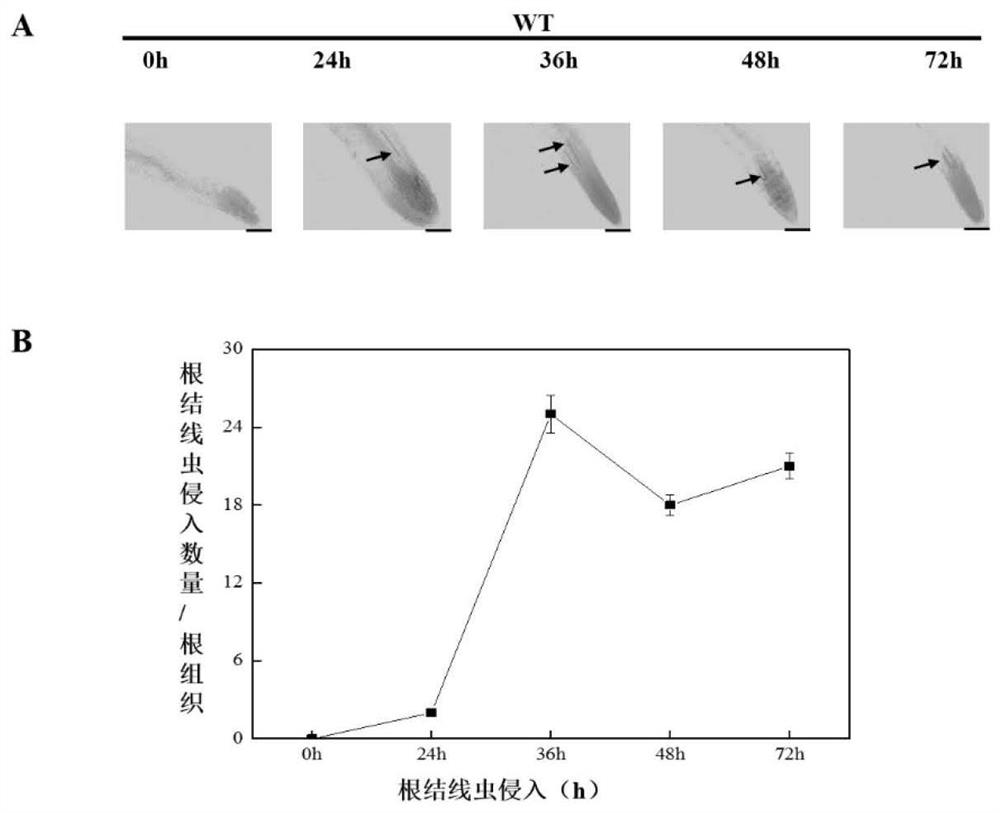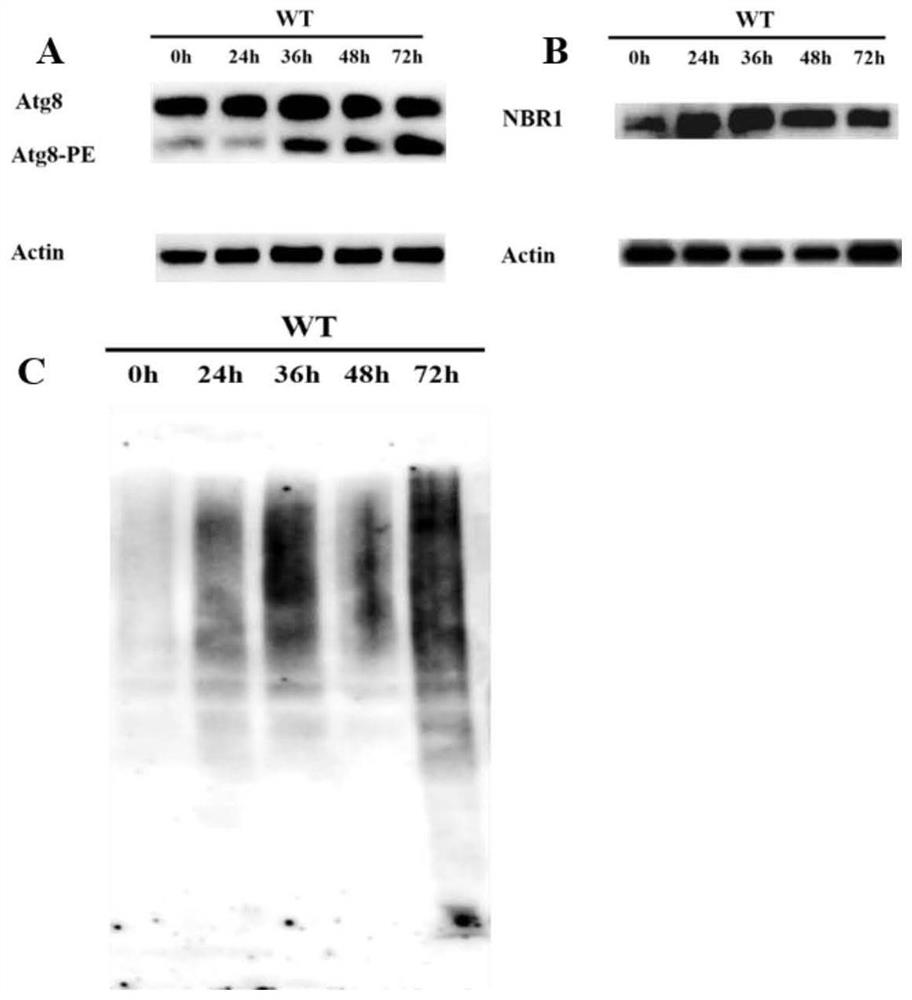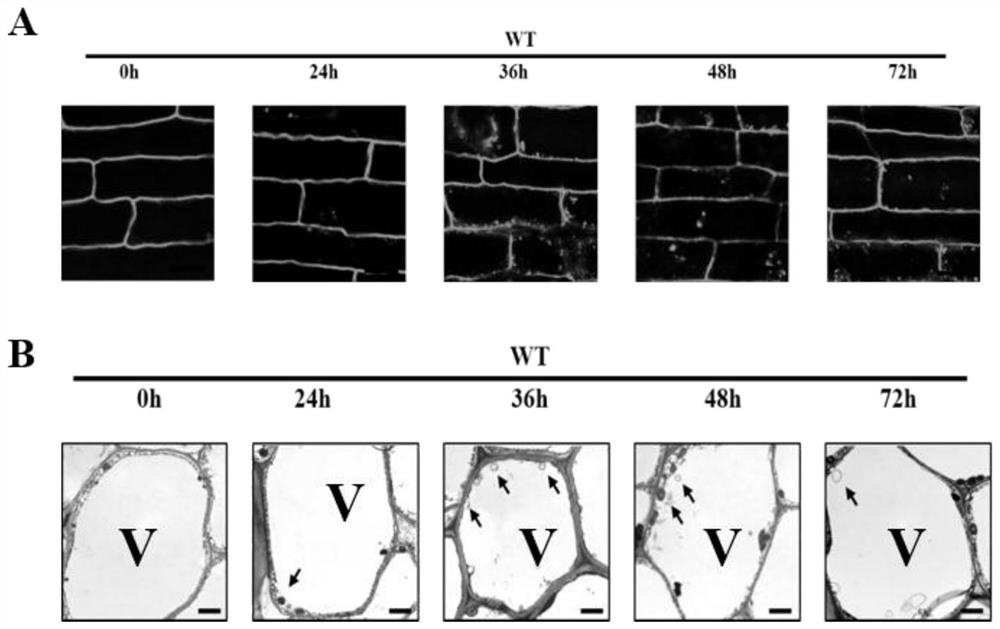Application of autophagy gene of tomatoes in improvement on root-knot nematode resistance of plants
A technology of autophagy genes and root-knot nematodes, applied in the fields of application, plant peptides, plant products, etc., can solve the problems of lack and less regulation of plant autophagy
- Summary
- Abstract
- Description
- Claims
- Application Information
AI Technical Summary
Problems solved by technology
Method used
Image
Examples
Embodiment 1
[0090] RKN treatment induces autophagy in wild-type tomato
[0091] RKN treatment of wild-type tomato, the specific method is as follows: when the tomato grows to five leaves and one heart, inoculate nematode treatment, each plant is inoculated with about 1000 J2 stage nematodes, and water normally during this period.
[0092] a. Take tomato root samples at 0h, 24h, 36h, 48h, and 72h after inoculation, stain with acid fuchsin, and count the phenotype and invasion number of each root. figure 1 A is the RKN invasion in each root tip after staining with acid fuchsin Bar=100 μm; figure 1 B is the number of RKN invaded in each root.
[0093] b. After inoculation 0h, 24h, 36h, 48h, 72h, take tomato root samples, extract protein, and perform Western Blot. The specific method is as follows:
[0094] 1) Western Blot
[0095] Take 0.3g protein sample in a 1.5mL centrifuge tube, put steel balls into it, grind it into powder in a sample mill, add an appropriate amount of protein extrac...
Embodiment 2
[0103] Construction and Detection of Tomato ATG10 Overexpression Plants
[0104] 1. Tomato Total RNA Extraction
[0105] Adopt Tiangen Plant total RNA extraction kit to extract the total RNA of tomato tender root, and its steps are:
[0106] (1) Take 0.1g tomato root sample and grind it in liquid nitrogen, add 1mL lysate RZ, and vortex to mix;
[0107] (2) Place at room temperature for 5 minutes to completely separate the nucleic acid-protein complex;
[0108] (3) Centrifuge at 12,000 rpm for 5 minutes at 4°C, remove the supernatant, and transfer to a new RNase-free centrifuge tube;
[0109] (4) Add 200 μL of chloroform, cover the tube cap, shake vigorously for 15 seconds, and place at room temperature for 3 minutes;
[0110] (5) 4°C, 12000rpm centrifuge for 10min, the sample will be divided into three layers: yellow organic phase, middle layer and colorless aqueous phase, RNA is mainly in the upper aqueous phase, the volume of the aqueous phase is about the lysate RZ reage...
Embodiment 3
[0152] Construction and detection of tomato atg10, atg4, atg6, atg7 mutant plants
[0153] 1. Tomato Total RNA Extraction
[0154] The total RNA of tomato tender roots was extracted using Tiangen Plant total RNA extraction kit, and the steps were the same as the above-mentioned total RNA extraction method.
[0155] 2. Gene cloning and construction of Agrobacterium tumefaciens engineering bacteria
[0156]Design the target sequences of tomato ATG10, ATG4, ATG6, and ATG7 genes on the CRISPR-P website (http: / / cbi.hzau.edu.cn / cgi-bin / CRISPR), and design primers to delete and edit large fragments of genes sgRNA-atg10-F1 (SEQ ID NO: 11), sgRNA-atg10-R1 (SEQ ID NO: 12), sgRNA-atg10-F2 (SEQ ID NO: 13), sgRNA-atg10-R2 (SEQ ID NO: 14 ). The remaining ATG4, ATG6, and ATG7 were designed in the same way, and the primer sequences were: sgRNA-atg4-F1, sgRNA-atg4-R1, sgRNA-atg4-F2, sgRNA-atg4-R2 (SEQ ID NO: 15-18) ; sgRNA-atg6-F1, sgRNA-atg6-R1, sgRNA-atg6-F2, sgRNA-atg6-R2 (SEQ ID NO: 19...
PUM
 Login to View More
Login to View More Abstract
Description
Claims
Application Information
 Login to View More
Login to View More - R&D Engineer
- R&D Manager
- IP Professional
- Industry Leading Data Capabilities
- Powerful AI technology
- Patent DNA Extraction
Browse by: Latest US Patents, China's latest patents, Technical Efficacy Thesaurus, Application Domain, Technology Topic, Popular Technical Reports.
© 2024 PatSnap. All rights reserved.Legal|Privacy policy|Modern Slavery Act Transparency Statement|Sitemap|About US| Contact US: help@patsnap.com










